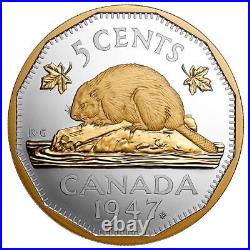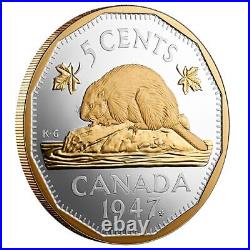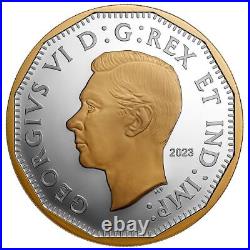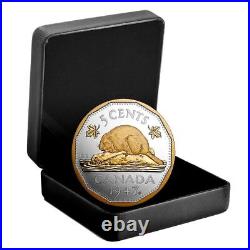2023 2oz Silver 5-Cent 1947 Maple Leaf Mark





This selectively gold-plated 2 oz. 99.99% pure silver coin is a timely look back at one of our most famous transitional issues: the 1947 Maple Leaf five-cent coin.
Faithfully re-sculpted using archived images from the Bank of Canada Museum, the historic reverse features the maple leaf mark that was added 75 years ago, in early 1948, to 1947-dated coins struck after India gained its independence from British rule. That small maple leaf alludes to imminent change: the removal of "IND: IMP:" ("Emperor of India") from the outmoded obverse legend, which has also been reproduced on this limited collectible that brings the past to life.
The 1947 Maple Leaf Mark After India gained its independence from British rule in 1947, Canadian coinage required new obverses without the outmoded "IND: IMP:" ("Emperor of India") in the legend. But in early 1948, Canada's Mint was still awaiting new matrices and punches from the Royal Mint, which still produced all die-sinking tools for its former Ottawa branch. The demand for new coins of every denomination proved too great, so a small maple leaf was placed next to the year "1947" on the old dies, where this maple leaf mark helped to differentiate these antedated 1948 issues from regular strikes. New master tooling arrived later that year, but by then, more than nine million 1947 Maple Leaf five-cent coins had already been struck; as a result, just 1,810,789 five-cent coins were produced with the updated obverse and a true date of 1948. KEY FEATURES: A faithful tribute. Step back in time with this re-creation of a famous transitional issue! The original 1947 Maple Leaf five-cent coin was struck in 1948 while awaiting a new obverse, one without "IND: IMP:" in the legend, after India gained its independence from British rule. Silver and selective gold plating. Of 99.99% pure silver, this near-faithful reproduction of a historic coin is enhanced with selective gold plating on its obverse and reverse. A re-creation of a classic. Both the obverse and reverse designs have been re-created using modern techniques and archival photographs. The year "1947" is key to the story and it appears on your coin's reverse, just like the original coin. The issuing year "2023" has been moved to the obverse and made less prominent in order to keep the focus on the historically significant elements.The Royal Canadian Mint certifies all of its collector coins. PACKAGING: Your coin is encapsulated and presented in a black Royal Canadian Mint-branded clamshell with a black beauty box.
